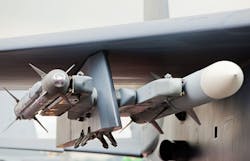Behlman to provide avionics test and measurement equipment for Navy aircraft weapons launchers
LAKEHURST, N.J. – U.S. Navy aircraft weapons experts needed avionicstest and measurement equipment for missile and weapons launchers aboard the F/A-18 jet fighter bomber and other combat aircraft. They found their solution from Behlman Electronics Inc. in Hauppauge, N.Y.
Officials of the Naval Air Warfare Center Aircraft Division in Lakehurst, N.J., announced a $21.7 million contract to Behlman on Thursday to build as many as 180 Common Aircraft Armament Test Sets (CAATS) and 100 Pure Air Generator System Adapter Sets (PAGS PAS).
The CAATS/PAS helps test and troubleshoot U.S. Navy, Marine Corps, and international military bomb racks, missile launchers, pylons and emerging weapons carriage devices across most aircraft weapons systems at the intermediate maintenance level.
Behlman will build weapons-launcher test and measurement equipment for the Navy and Marine Corp., as well as for the militaries of Spain, Italy, Finland, and Kuwait.
The CAATS system tests rack and launcher weapons interfaces off the aircraft prior to the loading of ordnance to ensure proper system functionality and safety.
Related: Navy orders missile launchers from Marvin to enable F/A-18 to fire AMRAAM, AIM-9X missiles
The CAATS/PAS replaces the legacy A/E37T-35A common rack and launcher test set (CRALTS) which has reliability and obsolescence issues as well as design limitations that limit its ability to support future requirements.
The PAS interfaces with the CAATS to test the LAU-7 and LAU-127 hi-pressure pure air generator (HiPPAG) weapons launchers. It provides pressure test capability to evaluate emerging pneumatic pressure release launchers such as the Joint Miniature Munitions Bomb Rack Unit.
The LAU-7 air-to-air missile launcher carries and deploys the AIM-9 missile heat-seeking missile and instrumentation pods on Navy and Marine Corps F/A-18 fighter-bombers. The LAU-127 missile rail launcher, meanwhile, enables the F/A-18 to carry and launch the radar-guided AIM-120 Advanced Medium-Range Air-to-Air Missile (AMRAAM) and the AIM-9X advanced heat-seeking missile.
The LAU-127 provides the electrical and mechanical interface between the AMRAAM and AIM-9X missiles and the F/A-18 aircraft, as well as the two-way data transfer between the missile and the aircraft's cockpit controls and displays.
Related: Raytheon to carry out revolutionary new test and measurement for SM-3 missile circuit cards
The electrical interfaces between the LAU-127 and the F/A-18 air crew also supports preflight orientation and control circuits to prepare and launch the missiles.
The Raytheon AMRAAM is an advanced radar-guided missile with day and night, all-weather capability that provides the F/A-18 pilot with launch-and-leave ability . It offers immunity to countermeasures, and the ability to reject radar clutter to attack low-altitude targets.
The Raytheon AIM-9X is a relatively short-range infrared heat-seeking missile that equips most jet fighters, fighter-bombers, and other offensive combat aircraft in the U.S. arsenal. It works by homing in on an enemy aircraft's hot engine exhaust. Variants of the AIM-9 Sidewinder have been deployed since the 1950s.
On this contract Behlman will do the work in Hauppauge, N.Y., and Indianapolis, and should be finished by September 2020. For more information contact Behlman Electronics online at www.behlman.com, or the Naval Air Warfare Center Aircraft Division-Lakehurst at www.navair.navy.mil/nawcad/lakehurst.
Learn more: search the Aerospace & Defense Buyer's Guide for companies, new products, press releases, and videos

